Influence of Variotropy on the Change in Concrete Strength under the Impact of Wet–Dry Cycles
Abstract
:1. Introduction
1.1. Background
1.2. Rationale
- (1)
- a review and analysis of the literature evaluating the effects of alternating wetting and drying cycles on concrete in general, with a focus on vibrated plain concrete;
- (2)
- development of an own method for determining the resistance and differentiation of the properties of concrete subjected to alternate wetting and drying, depending on the technology of its manufacture;
- (3)
- conducting experimental studies to confirm the hypothesis put forward about the higher resistance to alternating moistening and drying of variotropic concretes and, thereby, higher efficiency for operation under cyclic impacts of variotropic reinforced concrete structures;
- (4)
- determination of the possibility of considering the differentiation of concrete properties in the event of its variability in reinforced concrete structures made by centrifugal compaction methods;
- (5)
- determination of further prospects for the scientific development of this theory, as well as determination of the practical applicability of the scientific results obtained during the study.
2. Materials and Methods
2.1. Materials
2.2. Methods
3. Results
4. Discussion
5. Conclusions
- (1)
- With an increase in the number of moistening and drying cycles, at first there is a slight increase in the strength characteristics of the samples, and then there is a decrease.
- (2)
- The loss of cubic compressive strength after 600 wet–dry cycles for vibrating concretes was 36% at pH 5, 20% at pH 7, and 23% at pH 10; for centrifuged concretes, the cubic compressive strength decreased by 28% at pH 5, by 14% at pH 7 and by 18% at pH 10. For vibrocentrifuged concretes, the reduction in cubic strength was 21%, 10%, and 15% for pH 5, pH 7, and pH 10, respectively.
- (3)
- The prismatic compressive strength decreased similarly to the cube strength: the losses at various levels of pH 5, pH 7 and pH 10 were 37%, 22%, and 22% for vibrated concrete, 26%, 15%, and 18% for centrifuged concrete, and for vibrocentrifuged concrete, 20%, 11%, and 14%, respectively.
- (4)
- An acidic medium has the most negative effect on the strength characteristics of concretes made using various technologies, compared with neutral and alkaline media. The loss of strength of concrete when moistened in an acidic media was greater than in an alkaline and especially neutral media.
- (5)
- Vibrocentrifuged concrete turned out to be more resistant to aggressive environments and moistening and drying cycles than centrifuged and vibrated concrete. The drop in strength was up to 7% less compared to centrifuged concrete and up to 17% less than vibrated concrete.
- (6)
- Prospects for the practical application of the results obtained lie in the manufacture of real factory centrifuged and vibrocentrifuged reinforced concrete structures with a study of the possibility of using smaller grades for water resistance and lower consumption of materials, taking into account the fact that an additional protective effect will be created in the protective layer of concrete by creating variotropically improved vibrocentrifuged and centrifuged concrete structures.
- (7)
- Prospects and directions for the development of research are seen in checking the water resistance and resistance to moisture and drying of concretes of higher classes and densities, as well as concretes with reduced density, lightened using porous aggregates, or combined aggregates.
Author Contributions
Funding
Institutional Review Board Statement
Informed Consent Statement
Data Availability Statement
Acknowledgments
Conflicts of Interest
References
- Li, H.; Liu, J.; Chu, F.; Zhang, L. Study on Mix Proportion Design Based on Strength and Sulfate Resistance of 100% Recycled Aggregate Concrete. Buildings 2022, 12, 1467. [Google Scholar] [CrossRef]
- Lu, F.; Wang, H.; Wang, L.; Zhao, K.; Zhang, J. Degradation Law and Service Life Prediction Model of Tunnel Lining Concrete Suffered Combined Effects of Sulfate Attack and Drying–Wetting Cycles. Materials 2022, 15, 4435. [Google Scholar] [CrossRef]
- Hua, M.; Chen, B.; Liu, Y.; Liu, H.; Zhu, P.; Chen, C.; Wang, X. Durability and Abrasion Resistance of Innovative Recycled Pervious Concrete with Recycled Coarse Aggregate of Different Quality under Sulfate Attack. Appl. Sci. 2021, 11, 9647. [Google Scholar] [CrossRef]
- Liu, D.; Jian, Y.; Tang, Y.; Cao, K.; Zhang, W.; Chen, H.; Gong, C. Comprehensive Testing of Sulfate Erosion Damage of Concrete Structures and Analysis of Silane Coating Protection Effect. Sensors 2022, 22, 7991. [Google Scholar] [CrossRef] [PubMed]
- Wang, J.; Ye, X.; Li, L.; Liu, P. Distribution Law of Corrosion Products in a Marine Chloride Environment. Materials 2022, 15, 4339. [Google Scholar] [CrossRef]
- Cui, L.; Wang, H. Research on the Mechanical Strengths and the Following Corrosion Resistance of Inner Steel Bars of RPC with Rice Husk Ash and Waste Fly Ash. Coatings 2021, 11, 1480. [Google Scholar] [CrossRef]
- Qu, F.; Zhang, J.; Liu, G.; Zhao, S. Experimental Study on Chloride Ion Diffusion in Concrete Affected by Exposure Conditions. Materials 2022, 15, 2917. [Google Scholar] [CrossRef]
- Sun, R.; Wang, D.; Wang, Y.; Zhang, L.; Gu, Y. Durability and Improvement of Cement-Based Revetment Materials Serving in Subtidal, Intertidal, and Supratidal Environments. Materials 2022, 15, 3210. [Google Scholar] [CrossRef]
- Abubakar Ali, M.; Tomann, C.; Aldakheel, F.; Mahlbacher, M.; Noii, N.; Oneschkow, N.; Drake, K.-H.; Lohaus, L.; Wriggers, P.; Haist, M. Influence of Moisture Content and Wet Environment on the Fatigue Behaviour of High-Strength Concrete. Materials 2022, 15, 1025. [Google Scholar] [CrossRef]
- Li, L.; Shi, J.; Kou, J. Experimental Study on Mechanical Properties of High-Ductility Concrete against Combined Sulfate Attack and Dry–Wet Cycles. Materials 2021, 14, 4035. [Google Scholar] [CrossRef]
- Liu, J.; Zang, S.; Yang, F.; Zhang, M.; Li, A. Fracture Mechanical Properties of Steel Fiber Reinforced Self-Compacting Concrete under Dry–Wet Cycle Sulfate Attack. Buildings 2022, 12, 1623. [Google Scholar] [CrossRef]
- Marcos-Meson, V.; Fischer, G.; Solgaard, A.; Edvardsen, C.; Michel, A. Mechanical Performance of Steel Fibre Reinforced Concrete Exposed to Wet–Dry Cycles of Chlorides and Carbon Dioxide. Materials 2021, 14, 2642. [Google Scholar] [CrossRef] [PubMed]
- Xu, C.; Liao, H.-H.; Chen, Y.-L.; Du, X.; Peng, B.; Fernandez-Steeger, T.M. Corrosion Performance of Nano-TiO2-Modified Concrete under a Dry–Wet Sulfate Environment. Materials 2021, 14, 5900. [Google Scholar] [CrossRef] [PubMed]
- Liu, J.; Li, A.; Yang, Y.; Wang, X.; Yang, F. Dry–Wet Cyclic Sulfate Attack Mechanism of High-Volume Fly Ash Self-Compacting Concrete. Sustainability 2022, 14, 13052. [Google Scholar] [CrossRef]
- Wei, Y.M.; Chai, J.R.; Qin, Y.; Li, Y.L.; Xu, Z.G.; Li, Y.; Ma, Y.B. Effect of fly ash on mechanical properties and microstructure of cellulose fiber-reinforced concrete under sulfate dry–wet cycle attack. Constr. Build. Mater. 2021, 302, 124207. [Google Scholar] [CrossRef]
- Gao, D.; Yang, L.; Pang, Y.; Li, Z.; Tang, Q. Effects of a novel hydrophobic admixture on the sulfate attack resistance of the mortar in the wet-dry cycling environment. Constr. Build. Mater. 2022, 344, 128148. [Google Scholar] [CrossRef]
- Liu, F.; Zhang, T.; Luo, T.; Zhou, M.; Zhang, K.; Ma, W. Study on the Deterioration of Concrete under Dry–Wet Cycle and Sulfate Attack. Materials 2020, 13, 4095. [Google Scholar] [CrossRef]
- Guo, W.K.; Yang, Z.-Y.; Zhang, P.; Wang, Y.; Guo, J.; Guo, T. Effect of Dry–Wet Ratio on Properties of Concrete Under Sulfate Attack. Materials 2019, 12, 2755. [Google Scholar] [CrossRef] [Green Version]
- Wang, L.; Gao, M.; Zhang, J. Effect of Continuous Loading Coupled with Wet–Dry Cycles on Strength Deterioration of Concrete. Sustainability 2022, 14, 13407. [Google Scholar] [CrossRef]
- Liu, X.; Ma, E.; Liu, J.; Zhang, B.; Niu, D.; Wang, Y. Deterioration of an industrial reinforced concrete structure exposed to high temperatures and dry-wet cycles. Eng. Fail. Anal. 2022, 135, 106150. [Google Scholar] [CrossRef]
- Li, Y.; Yin, S.; Lv, H. Combined effects of dry-wet cycles and sustained loads on the seismic behavior of TRC-strengthened RC columns. Structures 2021, 33, 2226–2237. [Google Scholar] [CrossRef]
- Guo, J.-J.; Liu, P.-Q.; Wu, C.-L.; Wang, K. Effect of Dry–Wet Cycle Periods on Properties of Concrete under Sulfate Attack. Appl. Sci. 2021, 11, 888. [Google Scholar] [CrossRef]
- Wang, K.; Guo, J.; Wu, H.; Yang, L. Influence of dry-wet ratio on properties and microstructure of concrete under sulfate attack. Constr. Build. Mater. 2020, 263, 120635. [Google Scholar] [CrossRef]
- Rangel, C.S.; Amario, M.; Pepe, M.; Martinelli, E.; Toledo Filho, R.D. Influence of Wetting and Drying Cycles on Physical and Mechanical Behavior of Recycled Aggregate Concrete. Materials 2020, 13, 5675. [Google Scholar] [CrossRef] [PubMed]
- Zheng, S.; Qi, L.; He, R.; Wu, J.; Wang, Z. Erosion damage and expansion evolution of interfacial transition zone in concrete under dry-wet cycles and sulfate erosion. Constr. Build. Mater. 2021, 307, 124954. [Google Scholar] [CrossRef]
- He, R.; Zheng, S.; Gan, V.J.L.; Wang, Z.; Fang, J.; Shao, Y. Damage mechanism and interfacial transition zone characteristics of concrete under sulfate erosion and Dry-Wet cycles. Constr. Build. Mater. 2020, 255, 119340. [Google Scholar] [CrossRef]
- Wang, K.; Guo, J.; Yang, L.; Zhang, P.; Xu, H. Multiphysical damage characteristics of concrete exposed to external sulfate attack: Elucidating effect of drying–wetting cycles. Constr. Build. Mater. 2022, 329, 127143. [Google Scholar] [CrossRef]
- Lai, J.; Cai, J.; Chen, Q.-J.; He, A.; Wei, M.-Y. Influence of Crack Width on Chloride Penetration in Concrete Subjected to Alternating Wetting–Drying Cycles. Materials 2020, 13, 3801. [Google Scholar] [CrossRef]
- Sun, R.; Lu, W.; Ma, C.; Tawfek, A.M.; Guan, Y.; Hu, X.; Zhang, H.; Ling, Y.; Šavija, B. Effect of crack width and wet-dry cycles on the chloride penetration resistance of engineered cementitious composite (ECC). Constr. Build. Mater. 2022, 352, 129030. [Google Scholar] [CrossRef]
- Oneschkow, N.; Hümme, J.; Lohaus, L. Compressive fatigue behaviour of high-strength concrete in a dry and wet environment. Constr. Build. Mater. 2020, 262, 119700. [Google Scholar] [CrossRef]
- Utepov, Y.; Tulebekova, A.; Aldungarova, A.; Mkilima, T.; Zharassov, S.; Shakhmov, Z.; Bazarbayev, D.; Tolkynbayev, T.; Kaliyeva, Z. Investigating the Influence of Initial Water pH on Concrete Strength Gain Using a Sensors and Sclerometric Test Combination. Infrastructures 2022, 7, 159. [Google Scholar] [CrossRef]
- Guo, F.; Al-Saadi, S.; Singh Raman, R.K.; Zhao, X. Durability of Fibre Reinforced Polymers in Exposure to Dual Environment of Seawater Sea Sand Concrete and Seawater. Materials 2022, 15, 4967. [Google Scholar] [CrossRef] [PubMed]
- Saura, P.; Zornoza, E.; Andrade, C.; Ferrandiz-Mas, V.; Garcés, P. Composition of Corroded Reinforcing Steel Surface in Solutions Simulating the Electrolytic Environments in the Micropores of Concrete in the Propagation Period. Materials 2022, 15, 2216. [Google Scholar] [CrossRef] [PubMed]
- Kurpińska, M.; Haustein, E. Experimental Study of the Resistance to Influence of Aggressive Liquids on Lightweight Concrete. Materials 2021, 14, 4185. [Google Scholar] [CrossRef]
- Czajkowska, J.; Malarski, M.; Witkowska-Dobrev, J.; Dohojda, M.; Nowak, P. Mechanical Performance of Concrete Exposed to Sewage—The Influence of Time and pH. Minerals 2021, 11, 544. [Google Scholar] [CrossRef]
- Barbhuiya, S.; Kumala, D. Behaviour of a Sustainable Concrete in Acidic Environment. Sustainability 2017, 9, 1556. [Google Scholar] [CrossRef] [Green Version]
- Loh, P.Y.; Shafigh, P.; Katman, H.Y.B.; Ibrahim, Z.; Yousuf, S. pH Measurement of Cement-Based Materials: The Effect of Particle Size. Appl. Sci. 2021, 11, 8000. [Google Scholar] [CrossRef]
- Rasheed, P.A.; Nayar, S.K.; Barsoum, I.; Alfantazi, A. Degradation of Concrete Structures in Nuclear Power Plants: A Review of the Major Causes and Possible Preventive Measures. Energies 2022, 15, 8011. [Google Scholar] [CrossRef]
- Fang, J.; Ishida, T.; Fathalla, E.; Tsuchiya, S. Full-scale fatigue simulation of the deterioration mechanism of reinforced concrete road bridge slabs under dry and wet conditions. Eng. Struct. 2021, 245, 112988. [Google Scholar] [CrossRef]
- Xu, L.; Zhang, Y.; Zhang, S.; Fan, S.; Chang, H. Effect of Carbonation on Chloride Maximum Phenomena of Concrete Subjected to Cyclic Wetting–Drying Conditions: A Numerical and Experimental Study. Materials 2022, 15, 2874. [Google Scholar] [CrossRef]
- Li, D.; Li, L.-y.; Li, P.; Wang, Y.-c. Modelling of convection, diffusion and binding of chlorides in concrete during wetting-drying cycles. Mar. Struct. 2022, 84, 103240. [Google Scholar] [CrossRef]
- Zhou, Y.; Zheng, Y.; Sui, L.; Hu, B.; Huang, X. Study on the Flexural Performance of Hybrid-Reinforced Concrete Beams with a New Cathodic Protection System Subjected to Corrosion. Materials 2020, 13, 234. [Google Scholar] [CrossRef] [Green Version]
- Santana Rangel, C.; Pepe, M.; Amario, M.; Menegatti, L.C.; Martinelli, E.; Toledo Filho, R.D. Effects of Freeze-Thaw and Wet-Dry Cycles on Tension Stiffening Behavior of Reinforced RAC Elements. Appl. Sci. 2021, 11, 10063. [Google Scholar] [CrossRef]
- Arredondo-Rea, S.P.; Corral-Higuera, R.; Gómez-Soberón, J.M.; Gámez-García, D.C.; Bernal-Camacho, J.M.; Rosas-Casarez, C.A.; Ungsson-Nieblas, M.J. Durability Parameters of Reinforced Recycled Aggregate Concrete: Case Study. Appl. Sci. 2019, 9, 617. [Google Scholar] [CrossRef] [Green Version]
- Liang, H.; Li, S.; Lu, Y.; Yang, T. Reliability Analysis of Bond Behaviour of CFRP–Concrete Interface under Wet–Dry Cycles. Materials 2018, 11, 741. [Google Scholar] [CrossRef] [Green Version]
- Marcos-Meson, V.; Geiker, M.; Fischer, G.; Solgaard, A.; Jakobsen, U.H.; Danner, T.; Edvardsen, C.; Skovhus, T.L.; Michel, A. Durability of cracked SFRC exposed to wet-dry cycles of chlorides and carbon dioxide–Multiscale deterioration phenomena. Cem. Concr. Res. 2020, 135, 106120. [Google Scholar] [CrossRef]
- Shi-ping, Y.; Shi-chang, L.; Xun, S.; Xiang-qian, H. Study of the mechanical properties of TRC-strengthened eccentric columns exposed to dry and wet cycles in a chloride salt erosion environment. Eng. Struct. 2020, 204, 110014. [Google Scholar] [CrossRef]
- GOST 30744-2001 Methods of Testing with Using Polyfraction Standard Sand. Available online: https://docs.cntd.ru/document/1200011363 (accessed on 4 January 2023).
- GOST 8735-88 Sand for Construction Work. Testing Methods. Available online: https://docs.cntd.ru/document/1200003348 (accessed on 4 January 2023).
- GOST 8269.0-97 Mauntainous Rock Road-Metal and Gravel, Industrial Waste Products for Construction Works Methods of Physical and Mechanical Tests. Available online: https://docs.cntd.ru/document/1200003066 (accessed on 4 January 2023).
- Stel’makh, S.A.; Shcherban’, E.M.; Kholodnyak, M.G.; Nasevich, A.S.; Yanovskaya, A.V. Device for the Manufacture of Products from Vibrocentrifuged Concrete. Russian Federation Patent 197610, 29 January 2020. Available online: https://patentimages.storage.googleapis.com/99/a7/e4/7331df00d4bdba/RU197610U1.pdf (accessed on 4 January 2023).
- Beskopylny, A.N.; Shcherban’, E.M.; Stel’makh, S.A.; Mailyan, L.R.; Meskhi, B.; Evtushenko, A.; Varavka, V.; Beskopylny, N. Nano-Modified Vibrocentrifuged Concrete with Granulated Blast Slag: The Relationship between Mechanical Properties and Micro-Structural Analysis. Materials 2022, 15, 4254. [Google Scholar] [CrossRef]
- Nevskiy, V.A.; Yundin, A.N.; Konchichev, M.P.; Tkachenko, G.A. Durability of reinforced concrete trays and ways to improve it. Hydrotech. Melior. 1971, 2, 57–64. [Google Scholar]
- GOST 10180-2012 Concretes. Methods for Strength Determination Using Reference Specimens. Available online: http://docs.cntd.ru/document/1200100908 (accessed on 4 January 2023).
- GOST 24452-80 Concretes. Methods of Prismatic, Compressive Strength, Modulus of Elasticity and Poisson’s Ratio Determination. Available online: https://docs.cntd.ru/document/9056198 (accessed on 4 January 2023).
- GOST 10181-2014 Concrete Mixtures. Methods of Testing. Available online: https://docs.cntd.ru/document/1200115733 (accessed on 23 January 2023).
- Bartenev, G.M.; Lavrentev, V.V.; Payne, D.B.; Lee, L.-H.; Ludema, K.C. (Eds.) Foreword by P.A. Rebinder. In Tribology Series; Elsevier: Amsterdam, The Netherlands, 1981; Volume 6, p. xi. [Google Scholar] [CrossRef]
- Akhverdov, I.N. Fundamentals of Concrete Physics; Stroyizdat: Moscow, Russia, 1981; 464p, Available online: https://search.rsl.ru/ru/record/01001052337 (accessed on 4 January 2023).
- Bazhenov, Y.M.; Murtazaev, S.A.Y.; Alaskhanov, A.H.; Saydumov, M.S.; Bataev, D.K.S.; Murtazaeva, T.S.A. High-strength concretes based on anthropogenic raw materials for earthquake resistant high-rise construction. Eng. Solid Mech. 2021, 9, 335–346. [Google Scholar] [CrossRef]
- Beskopylny, A.N.; Stel’makh, S.A.; Shcherban’, E.M.; Mailyan, L.R.; Meskhi, B.; Beskopylny, N.; El’shaeva, D.; Kotenko, M. The Investigation of Compacting Cement Systems for Studying the Fundamental Process of Cement Gel Formation. Gels 2022, 8, 530. [Google Scholar] [CrossRef] [PubMed]
- Beskopylny, A.N.; Stel’makh, S.A.; Shcherban’, E.M.; Mailyan, L.R.; Meskhi, B.; Varavka, V.; Beskopylny, N.; El’shaeva, D. A Study on the Cement Gel Formation Process during the Creation of Nanomodified High-Performance Concrete Based on Nanosilica. Gels 2022, 8, 346. [Google Scholar] [CrossRef] [PubMed]
- Yang, S.; Chen, X.; Han, M.; Song, J. Effect of sulfate attack, drying-wetting cycles and freezing-thawing cycles on reinforced concrete columns under eccentric loads. Structures 2022, 45, 1864–1877. [Google Scholar] [CrossRef]
- Mailyan, L.R.; Stel’makh, S.A.; Shcherban, E.M. Differential characteristics of concrete in centrifugally spun and vibrospun building structures. Mag. Civ. Eng. 2021, 108, 10812. [Google Scholar] [CrossRef]
- Beskopylny, A.N.; Meskhi, B.; Stel’makh, S.A.; Shcherban’, E.M.; Mailyan, L.R.; Veremeenko, A.; Akopyan, V.; Shilov, A.V.; Chernil’nik, A.; Beskopylny, N. Numerical Simulation of the Bearing Capacity of Variotropic Short Concrete Beams Reinforced with Polymer Composite Reinforcing Bars. Polymers 2022, 14, 3051. [Google Scholar] [CrossRef] [PubMed]
- Beskopylny, A.N.; Stel’makh, S.A.; Shcherban’, E.M.; Mailyan, L.R.; Meskhi, B. Nano modifying additive micro silica influence on integral and differential characteristics of vibrocentrifuged concrete. J. Build. Eng. 2022, 51, 104235. [Google Scholar] [CrossRef]
- Beskopylny, A.N.; Stel’makh, S.A.; Shcherban’, E.M.; Mailyan, L.R.; Meskhi, B.; Beskopylny, N.; El’shaeva, D. Influence of the Chemical Activation of Aggregates on the Properties of Lightweight Vibro-Centrifuged Fiber-Reinforced Concrete. J. Compos. Sci. 2022, 6, 273. [Google Scholar] [CrossRef]

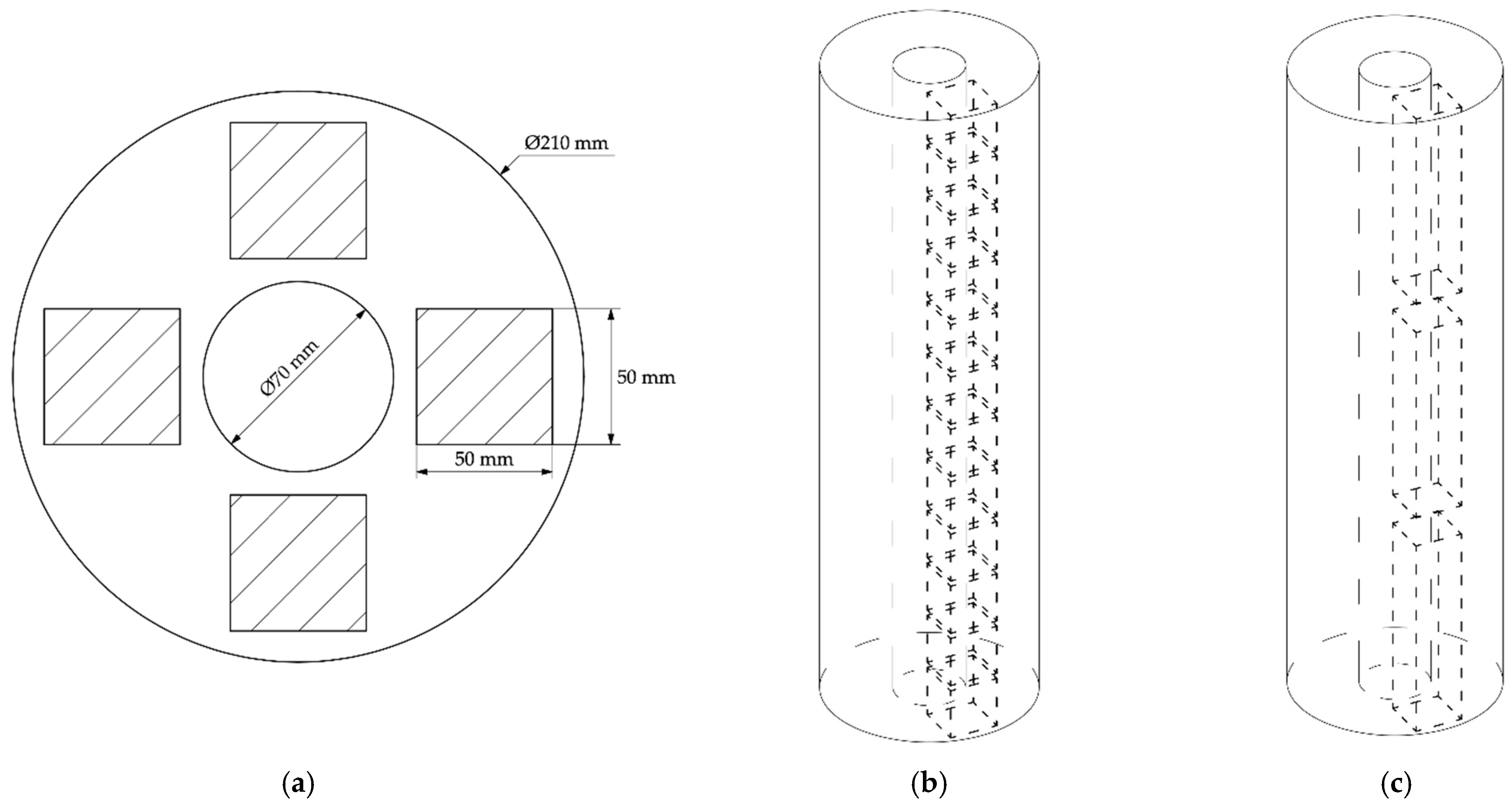

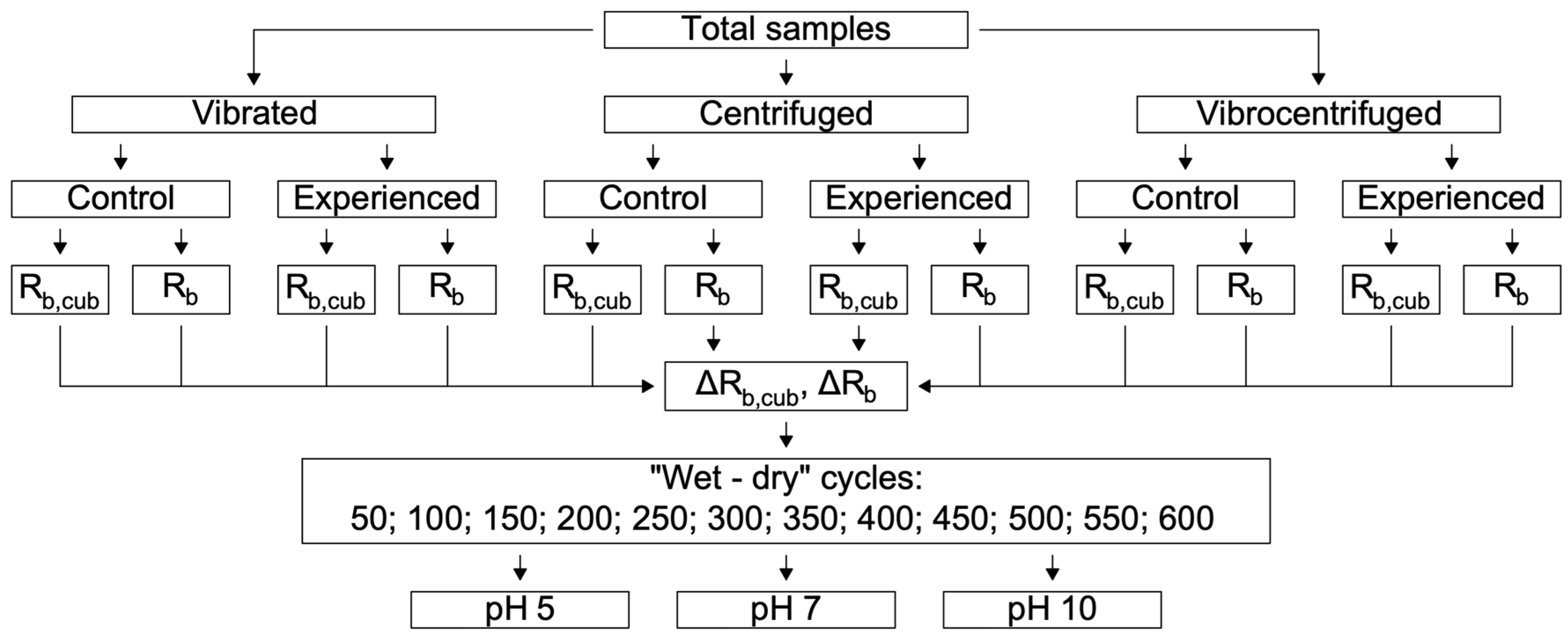

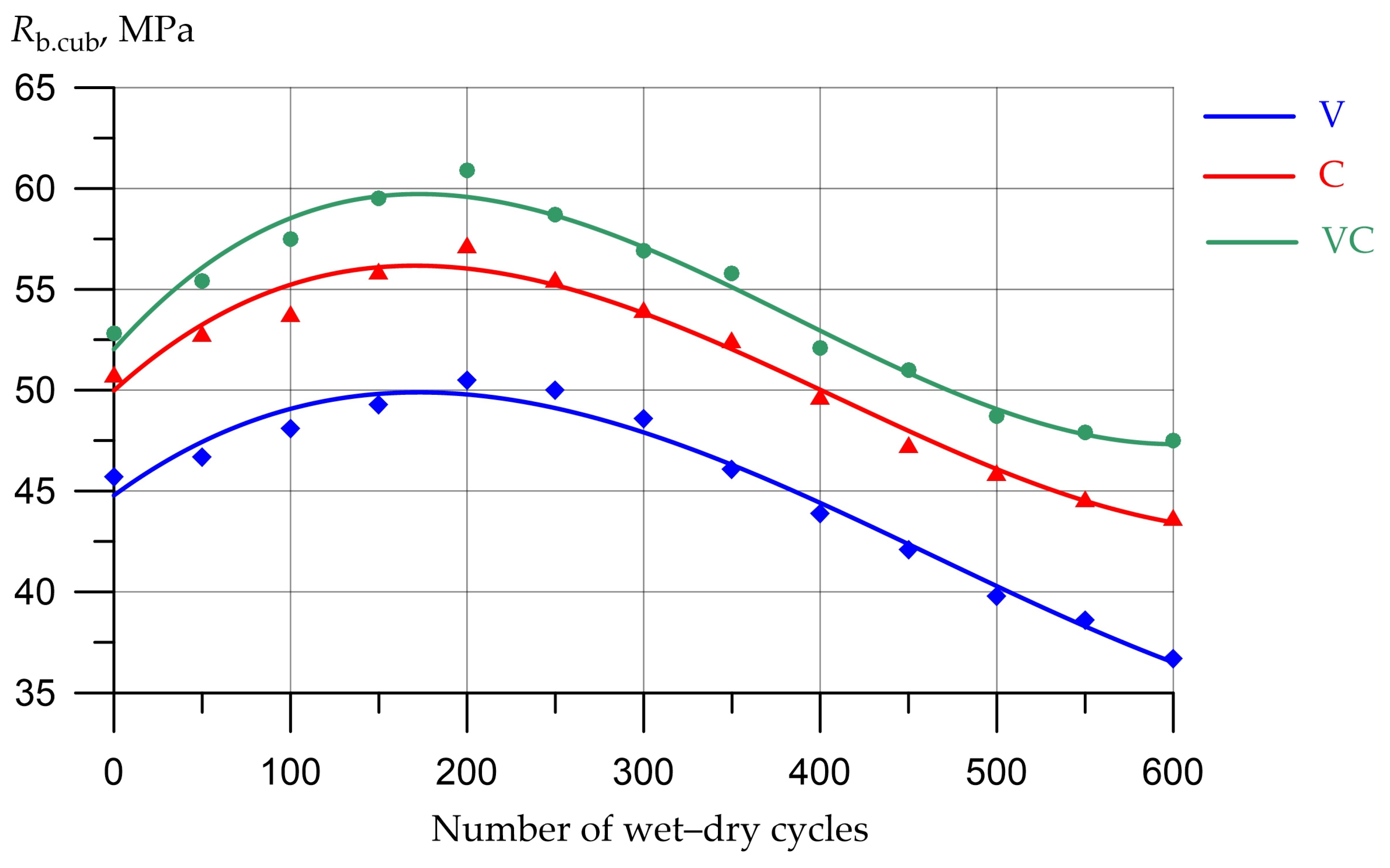
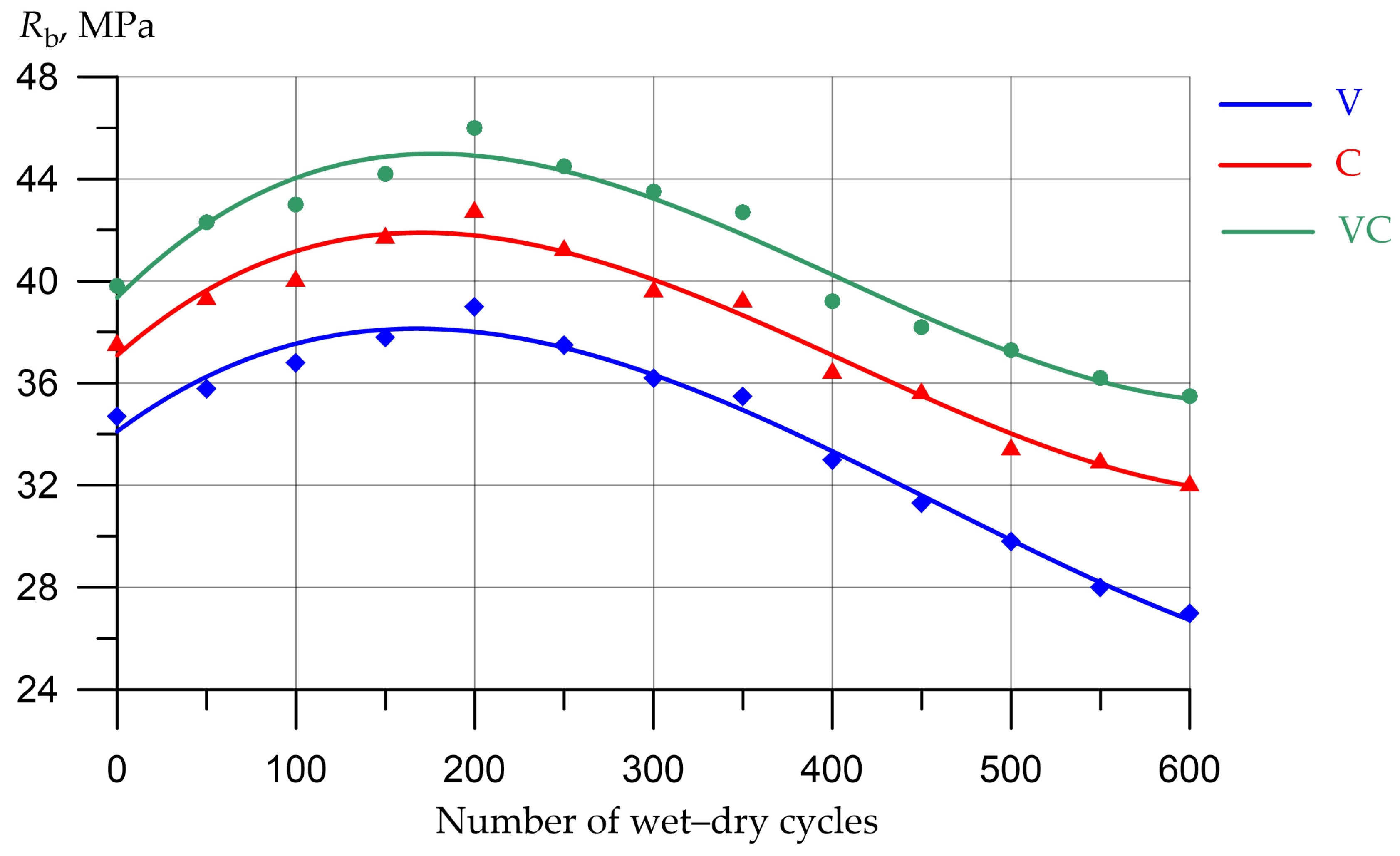
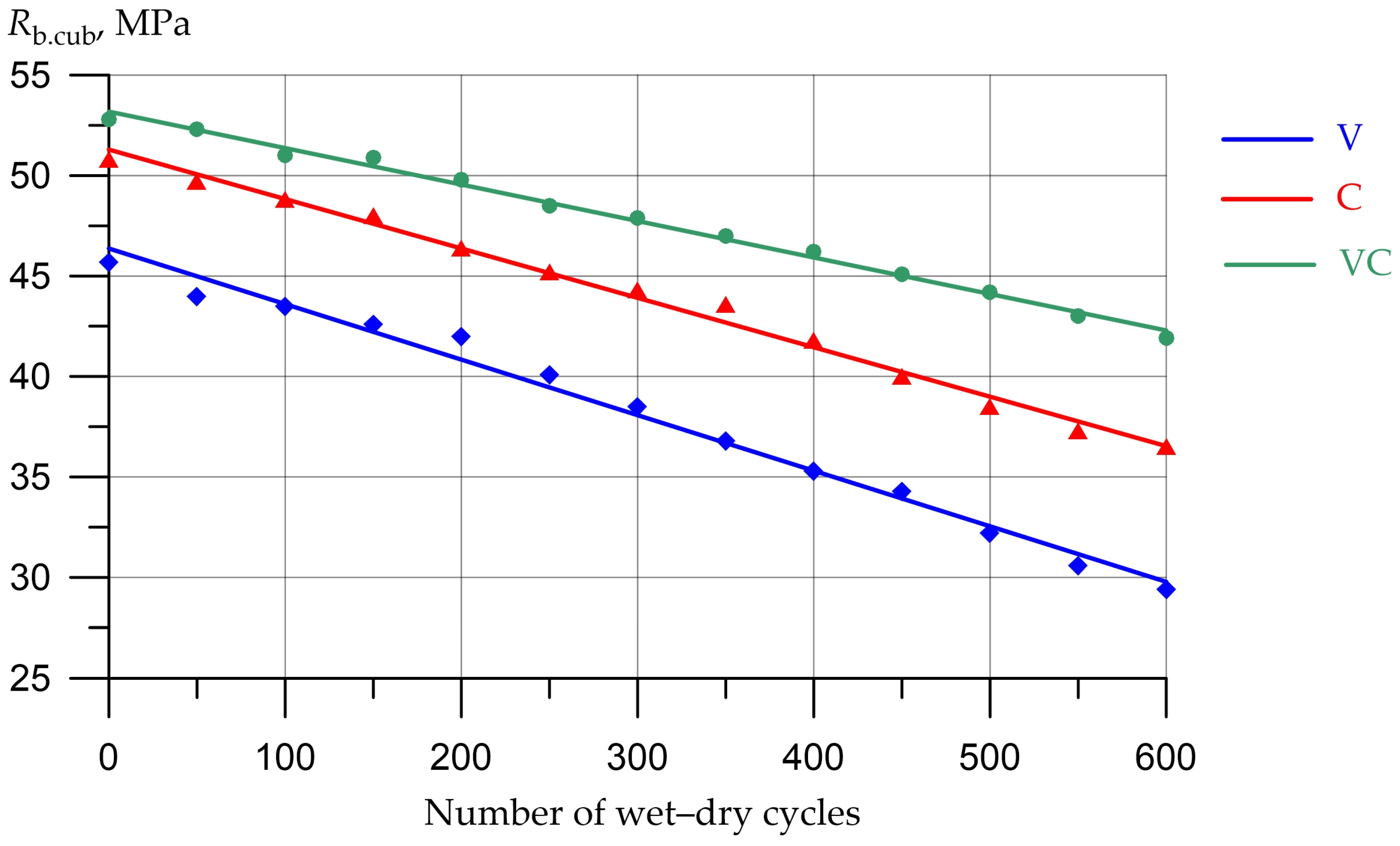


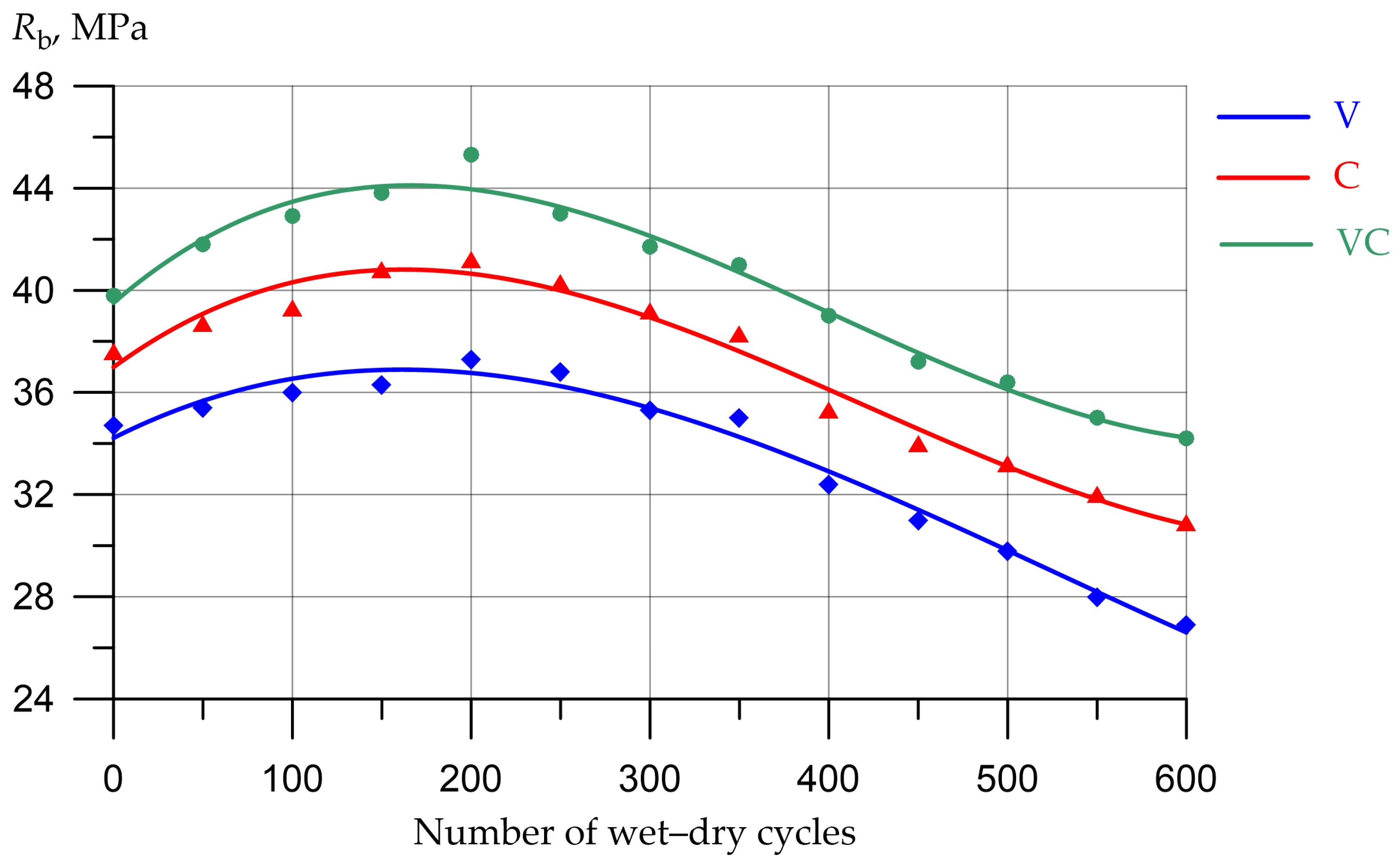
| Physical and mechanical properties | ||||||||||
| Compressive strength at the age of 2 days (28 days) (MPa) | Start setting (minutes) | Uniformity of volume change (expansion) (mm) | Grinding fineness (residue on sieve No. 008 (%) | |||||||
| 18.9 (50.4) | 135 | 1 | 3.6 | |||||||
| Chemical composition (%) | ||||||||||
| SiO2 | Al2O3 | Fe2O3 | MgO | CaO | SO3 | TiO3 | LOI | Na2O | K2O | Chlorine ion CI− |
| 22.65 | 4.13 | 3.96 | 1.29 | 62.2 | 1.68 | 0.05 | 3.69 | 0.12 | 0.22 | 0.01 |
| Mineralogical composition (%) | ||||||||||
| Tricalcium silicate | Dicalcium silicate | Tricalcium aluminate | Tetracalcium aluminoferrite | |||||||
| 65 | 17 | 7 | 11 | |||||||
| Crushability, (%) | The Content of Lamellar and Needle-Shaped Grains, (%) | The Content of Dust and Clay Particles, (%) | Grain Content of Weak Rocks, (%) | Bulk Density (kg/m3) | True Density (kg/m3) | Frost Resistance, Cycles |
|---|---|---|---|---|---|---|
| 11.5 (type 1000) | 10.5 (groop 2) | 0.5 | 2.1 | 1395 | 2658 | 200 (F200) |
| Size Modulus, Mf | The Content of Dust and Clay Particles, (%) | Clay Content in Lumps, (%) | Sand Class According to GOST 8736 | Bulk Density, (kg/m3) | True Density (kg/m3) |
|---|---|---|---|---|---|
| 2.1 (medium) | 1.6 | 0.12 | I | 1520 | 2603 |
| Technology | PC (kg/m3) | W (L/m3) | S (kg/m3) | CrS (kg/m3) |
|---|---|---|---|---|
| Vibration | 383 | 199 | 529 | 1160 |
| Centrifugation and vibrocentrifugation | 409 | 180 | 683 | 1182 |
| Type of Concrete | Number of Wetting and Drying Cycles | ||||||||||||
|---|---|---|---|---|---|---|---|---|---|---|---|---|---|
| 0 | 50 | 100 | 150 | 200 | 250 | 300 | 350 | 400 | 450 | 500 | 550 | 600 | |
| Vibrated | ΔRb.cub, % | ||||||||||||
| 0 | 2 | 5 | 8 | 11 | 9 | 6 | 1 | –4 | –8 | –13 | –16 | –20 | |
| ΔRb, % | |||||||||||||
| 0 | 3 | 6 | 9 | 12 | 8 | 4 | 2 | –5 | –10 | –14 | –19 | –22 | |
| Centrifuged | ΔRb.cub, % | ||||||||||||
| 0 | 4 | 6 | 10 | 13 | 9 | 6 | 3 | –2 | –7 | –10 | –12 | –14 | |
| ΔRb, % | |||||||||||||
| 0 | 5 | 7 | 11 | 14 | 10 | 6 | 5 | –3 | –5 | –11 | –12 | –15 | |
| Vibrocentrifuged | ΔRb.cub, % | ||||||||||||
| 0 | 5 | 9 | 13 | 15 | 11 | 8 | 6 | –1 | –3 | –8 | –9 | –10 | |
| ΔRb, % | |||||||||||||
| 0 | 6 | 8 | 11 | 16 | 12 | 9 | 7 | –2 | –4 | –6 | –9 | –11 | |
| Type of Concrete | Number of Wetting and Drying Cycles | ||||||||||||
|---|---|---|---|---|---|---|---|---|---|---|---|---|---|
| 0 | 50 | 100 | 150 | 200 | 250 | 300 | 350 | 400 | 450 | 500 | 550 | 600 | |
| Vibrated | ΔRb.cub, % | ||||||||||||
| 0 | –4 | –5 | –7 | –8 | –12 | –16 | –19 | –23 | –25 | –30 | –33 | –36 | |
| ΔRb, % | |||||||||||||
| 0 | –5 | –8 | –10 | –11 | –14 | –17 | –21 | –24 | –25 | –29 | –32 | –37 | |
| Centrifuged | ΔRb.cub, % | ||||||||||||
| 0 | –2 | –4 | –6 | –9 | –11 | –13 | –14 | –18 | –21 | –24 | –27 | –28 | |
| ΔRb, % | |||||||||||||
| 0 | –1 | –5 | –7 | –10 | –12 | –14 | –15 | –17 | –21 | –23 | –24 | –26 | |
| Vibrocentrifuged | ΔRb.cub, % | ||||||||||||
| 0 | –1 | –3 | –4 | –6 | –8 | –9 | –11 | –13 | –15 | –16 | –19 | –21 | |
| ΔRb, % | |||||||||||||
| 0 | –2 | –3 | –5 | –7 | –9 | –11 | –12 | –14 | –15 | –17 | –18 | –20 | |
| Type of Concrete | Number of Wetting and Drying Cycles | ||||||||||||
|---|---|---|---|---|---|---|---|---|---|---|---|---|---|
| 0 | 50 | 100 | 150 | 200 | 250 | 300 | 350 | 400 | 450 | 500 | 550 | 600 | |
| Vibrated | ΔRb.cub, % | ||||||||||||
| 0 | 1 | 3 | 6 | 10 | 9 | 4 | 2 | –6 | –10 | –15 | –18 | –23 | |
| ΔRb, % | |||||||||||||
| 0 | 2 | 4 | 5 | 7 | 6 | 2 | 1 | –7 | –11 | –14 | –19 | –22 | |
| Centrifuged | ΔRb.cub, % | ||||||||||||
| 0 | 2 | 5 | 8 | 11 | 8 | 5 | 1 | –4 | –9 | –11 | –15 | –18 | |
| ΔRb, % | |||||||||||||
| 0 | 3 | 5 | 9 | 10 | 7 | 4 | 2 | –6 | –10 | –12 | –15 | –18 | |
| Vibrocentrifuged | ΔRb.cub, % | ||||||||||||
| 0 | 4 | 7 | 11 | 12 | 9 | 6 | 2 | –2 | –6 | –10 | –13 | –15 | |
| ΔRb, % | |||||||||||||
| 0 | 5 | 8 | 10 | 14 | 8 | 5 | 3 | –2 | –7 | –9 | –12 | –14 | |
Disclaimer/Publisher’s Note: The statements, opinions and data contained in all publications are solely those of the individual author(s) and contributor(s) and not of MDPI and/or the editor(s). MDPI and/or the editor(s) disclaim responsibility for any injury to people or property resulting from any ideas, methods, instructions or products referred to in the content. |
© 2023 by the authors. Licensee MDPI, Basel, Switzerland. This article is an open access article distributed under the terms and conditions of the Creative Commons Attribution (CC BY) license (https://creativecommons.org/licenses/by/4.0/).
Share and Cite
Beskopylny, A.N.; Stel’makh, S.A.; Shcherban’, E.M.; Mailyan, L.R.; Meskhi, B.; Chernil’nik, A.; El’shaeva, D.; Pogrebnyak, A. Influence of Variotropy on the Change in Concrete Strength under the Impact of Wet–Dry Cycles. Appl. Sci. 2023, 13, 1745. https://doi.org/10.3390/app13031745
Beskopylny AN, Stel’makh SA, Shcherban’ EM, Mailyan LR, Meskhi B, Chernil’nik A, El’shaeva D, Pogrebnyak A. Influence of Variotropy on the Change in Concrete Strength under the Impact of Wet–Dry Cycles. Applied Sciences. 2023; 13(3):1745. https://doi.org/10.3390/app13031745
Chicago/Turabian StyleBeskopylny, Alexey N., Sergey A. Stel’makh, Evgenii M. Shcherban’, Levon R. Mailyan, Besarion Meskhi, Andrei Chernil’nik, Diana El’shaeva, and Anastasia Pogrebnyak. 2023. "Influence of Variotropy on the Change in Concrete Strength under the Impact of Wet–Dry Cycles" Applied Sciences 13, no. 3: 1745. https://doi.org/10.3390/app13031745
APA StyleBeskopylny, A. N., Stel’makh, S. A., Shcherban’, E. M., Mailyan, L. R., Meskhi, B., Chernil’nik, A., El’shaeva, D., & Pogrebnyak, A. (2023). Influence of Variotropy on the Change in Concrete Strength under the Impact of Wet–Dry Cycles. Applied Sciences, 13(3), 1745. https://doi.org/10.3390/app13031745












